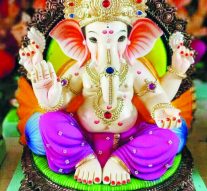Goa is abuzz with excitement as vintage bike and car owners, users, collectors and fans are decking […]

OM GANESHA NAMAHA!
Aug 23- Aug 29, 2025, Cover Story August 22, 2025BY Rajan Narayan
I HAVE always had a very close, friendly relationship with my elephant-headed and pot-bellied Ganesha. My tryst with Lord Ganesh goes back to my childhood. I was fascinated by the stories of Lord Ganesh. This story is Lord Shiva, in a fit of anger, beheaded his son who was standing guard at the door as his mother Parvati was having a bath.
When Shiva discovered that he had killed his own son, he decided to restore him to life. Shiva ordered his devotees to bring him the head of the first creature they found that was facing north, and they returned with a baby elephant’s head. Lord Shiva transplanted his young son’s head with the baby elephant’s head for he had killed his son incidentally. You may say this was first neurosurgery surgery involving the transplant of an entire head.
Parvathi was not very happy with her son being restored with an elephant’s head. To make amends Lord Shiva decreed that Lord Vinayaka would be the first amongst all gods. The tradition continues as the image of Lord Ganesha or Vinayaka is worshiped first as the start of every puja in Hindu ritual rites. This is because Lord Vinayaka is perceived as the god who is the remover of all obstacles.
The Ganesh Chaturthi or Chovoth festival in Goa is celebrated with as much fervor in Tamil Nadu too, as in Goa. As in the case of Goa, there are many hymns or “bhajana” in praise of Lord Ganesh. One bhajan I recall is “Moushil vahana Gajanana, Parvathi putra gajanana.” This literary means the lord who chose the humble mouse as his “vahan” (transport). This is unlike the other Hindu gods, like Durga, who rides the tiger, and Murugan who rides the peacock.
There is a charming story on why the first day of Chovoth, as it is called in Goa, is always celebrated on “amavasya” day or moonless night. The story goes that the moon laughed when Ganesh fell off his mouse while rushing home. Ganesh was so angry that he cursed the moon. Ever since the installation or coming home of Lord Ganesh deity takes place on full moon night, which is considered an inauspicious time by the Hindu calendar.
Ganesh, unlike many other Hindu gods, likes the good life and does not ask you to fast. On the contrary, Lord Ganesh encourages you to feast all through the 11-day festival. It is clear that Vinayaka loves his modak. In Maharashtra these are traditionally made of steamed rice dough molded into a “modak” filled with a sweet a sweet filling. There are also the non-sweet versions with their filling of sprouted pulses in down south India in Tamil Nadu.
Please stay away from the commercial range of colored so called “mava” modak sweets. In fact, all mithai shops stock these mini and maxi flour and mava mixed modak to sell to their Ganesh loving consumers. These corrupted versions of adulterated sweet modak are an insult to Lord Ganesh.
Goa never has had a tradition of Sarvajanik Ganesh. This community tradition has been borrowed from neighboring Maharashtra. The great freedom fighter Lokmanya Tilak promoted the Ganesh festival as a community festival to protest against British colonial rule. And so Sarvajanik Ganesh worshipping has become huge commercial event, particularly in Mumbai. The biggest and the richest Ganesh is the Lal Bagh Raja in the heart of the old textile mills area of central Mumbai. The Lal Bagh Raja may be over ten meters tall and heavily adorned with real gold jewelry. This Rana attracts all the filmstars of Mumbai besides of course the politicians.
The community Ganesh is getting bigger and bigger in Goa too. Among the most visited is the community Lord Ganesh in Quepem. The celebration is largely financed through donation coupons costing between Rs100 and Rs1,000. The Quepem Mandal offers the biggest cash prices going up to Rs 25 lakh and in recent time they have also offer a flat, along with of course several cars, scooters and even electric vehicles.
EVERY police station in Goa has its own Lord Ganesh platform or pandal. Perhaps the largest Ganesh-worshipping community in Goa resides at Azad Maidan in Panaji, where major cultural events are organized all days of the festival. But for Goans, the Lord Ganesh festival is primarily a family affair in which the entire extended family of uncles, nephews, children and grandchildren come together in the family ancestral house. However, even the poorest of Goan families celebrate the Lord Ganesh in great style ceremony.
Our Gaudi tribal help’s family from Aivo village at Dona Paula invests in a large Lord Ganesh idol costing Rs5,000 plus come every festival. The traditional seven-day stay of Lord Ganesh at home has now been cut down to one-and-a-half day.
This is the time of the year when all Goan business establishments shut down for a minimum of five or seven days. All working employees go home for the festival and no one comes to work in government offices for at least a minimum of a week. So officially there are two government holidays for Lord Ganesh with the third one on “visarjan” or immersion day. Only the starred hotels remain open for business with scanty staff.
Chovoth of course has become big business and every years an appeal goes out not to sell or buy plaster of Paris Ganesh idols or images for these are very eco-unfriendly. These POP idols are of artificial material and do not dissolve in water when they’re immersed in water bodies. One of the ugliest sights to see on the seashore is the return of all the broken debris of the immersed Lord Ganesh idols. This includes dead marine life in off-shore sea waters which have poisoned by the immersed idols chemical paintwork which dissolves in the water. People are advised not to buy the highly chemically painted idols for their festival celebration, but to buy the Ganesh idols of clay and mud and painted with vegetable dyes.
In fact eco-friendly Lord Ganesh are becoming popular and many have their own village artist who does the idols traditionally, in villages like Bicholim and Canacona it is easy to buy an all eco-friendly Lord Ganesh idol for worshiping during the festival. Most of these beautiful idols are made by the very talented Chari community.
I recall our one time art director, Deepak Chari, presenting me with very charming little Ganesh idols of clay every year. The most important and difficult part in the creation of the elephant god’s image is the eyes. You require genius patience to do the eyes of Lord Ganesh which have to exude truly benign love and compassion.
So we say forget the POP China made idols of Lord Ganesh flooding the market, as well as the decorations. Stay with the traditional Lord Ganesh and of course concentrate on the canopy or “matoli” of natural foliage, fruit and flowers foraged from the forest…which is the unique feature of Goa’s Chovoth festival. This is also a bumper time for bhatji or priests of temples to be invited home to perform the installation and immersion asion e Bhatjis, without whose blessings lord Ganesh cannot enter the house. The idol is normally kept inside till the bhatji arrives and do puja. There is huge demand for bhatjis the majority are imported from neighbouring Karnataka, a large part of them from the temple town of Gokarna.
We are happy to invoke the blessing of Lord Vinayaka on this Ganesh Chaturthi. Thank you my friend Ganesha for all your blessings. Whom I recover from steroids and of course from my almost recovery from TB. May you continue to remove all obstacles from the part of the family friends, well-wishers and indeed every Goenkar, including migrants living in Goa from all communities.














